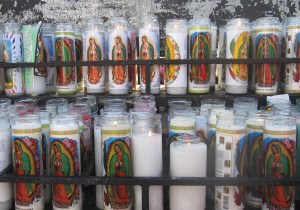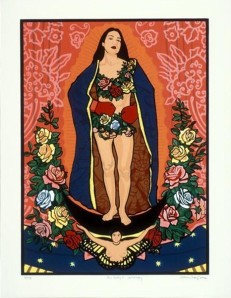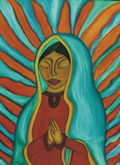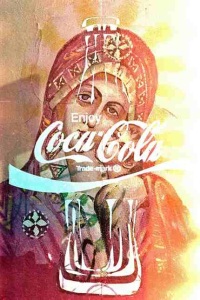December marks the feast day of Our Lady of Guadalupe, one of the most recognizable religious figures in the world. Her image has been used to help comfort people suffering from hardships and has given others a sense of identity and place. Judging from the works on display around Los Angeles, artists still get inspiration from this nearly 500-year-old Catholic icon.
by Lydia Breen
Kathy Gallegos, an artist of Cuban and Puerto Rican heritage, doesn’t usually paint Our Lady of Guadalupe in her work. But she put the Virgin’s image in her painting, Ralphy‘s Pain, because she thought it might help a co-worker recover from a traumatic loss.
“The painting came about because of a man, whose name was Ralphy. He ran the copy machine in the law office where I worked. One day he came in with his hair all shaved off, looking like he had been crying for weeks. It turned out his nephew and his sister – and I think also his mother – were all killed in a car crash.”
Gallegos asked Ralphy if she could paint his portrait, believing it somehow might help him heal. “He was in so much pain. He looked kind of numb,” she said. “It bothered and disturbed me to see him. He looked like his soul was gone.”
She painted his portrait and added tattoos on his arm of the names of the family members who had died, written in Chinese characters. She set him surrounded with cactus “because he was in such a painful place.” Then she added the image of the Virgin of Guadalupe.
“I put her in there, floating over him. I didn’t want to show a static Virgin. I wanted her to be doing what she is supposed to do. She is supposed to heal, protect and guide – that’s the reason why people pray to her.”
“I believe in the power of a painting. When an artist paints, it is a prayer. You are in a special place. You are connecting with something mystical,” Gallegos said. Her painting imagined Raphy’s pain – and the possibility of his healing.
“I believe when artists are in tune with their soul, they are visionaries.”

San Francisco muralist, Patricia Rose, painted this image of the Virgin at the entry of Balmy Alley,in the Mission District. "I'm a big fan of the Virgin," she said. " Just made only two changes: I flipped the direction she faces, to make her look into the alley, and I painted her eyes open. She's a mother, so she would have to be watchful." Patricia Rose conducts tours of S.F. murals for Precita Eye Mural Arts Center.
Evonne Gallardo, Executive Director of Self-Help Graphics in East Los Angeles says she sees great diversity in the way artists interpret the symbol of the Virgin of Guadalupe.
“It’s amazing when you pick one image like the mother of Jesus,” she said. “Men and women see her differently. I think many women see her as a conduit, a doorway. She’s a tangible connection to the divine. She made many sacrifices for someone she loved – that’s a universal experience for women.”
Although the Virgin of Guadalupe’s image is nearly 500 years-old, the Virgin retains contemporary appeal.
“She had quite a bohemian lifestyle,” Gallardo says. “And she was a leader, a respected member of her community.”
Gallardo points to Yolanda Lopez’ 1978 photo montage that was exhibited as a poster at Self-Help Graphics. Portrait of the Artist as the Virgin of Guadalupe shows an athletic woman fully in control of her environment, holding a serpent –a symbol of the Aztec goddess of fertility, Caotlalopeuh.
The piece was created at the height of identity politics in the United States. Lopez says her intention was to portray a positive role model for working-class Chicanas and Latinas, like herself.
“The ideal was white, and I was not,” she explained in interview with Amalia Mesa-Bains. “I knew very well that I didn’t look like that. So I never considered myself pretty…I feel living, breathing women also deserve respect and love lavished on Guadalupe. I have chosen to transform the image. Taking symbols of her power and virtue I have transferred them to portraits of women I know…”
In 2003, Self-Help Graphics exhibited a poster of a work by lesbian artist Alama Martinez entitled, Our Lady of Controversy, in which the Virgin appears as a prize-fighter dressed in boxing gloves, a cape and garlands of flowers covering her otherwise-naked body. She stands on a pedestal shaped like a crescent moon, held up by a bare-breasted angel.
When the work was exhibted in New Mexico Archbishop Michael Sheehan of New Mexico, was outraged, saying Virgin was dressed “like a tart.”
Protests outside Self-Help Graphic’s East L.A. building were staged by members of the Sociedades Guadalupanas – a conservative Catholic society of women who took offense at the depiction of a nude Virgin. Across the street, a counter-demonstration defended Alma Martinez’ free speech rights.
Gallardo believes the protests were an example of the broad range of views that exist within the Chicano/Latino community.
“I wasn’t planning on building a body of work around the Virgin of Guadalupe,” explains Los Angeles photographer, Johnny Nicoloro. “The first piece I did I was driving to another event in Korea Town where I saw a Latin market. Outside, the owners had painted the Virgin Mary and next to it they painted an image of a Coca-Cola bottle. I do double exposures. So I took the first image and then the second and laid it in the camera.”
“I was raised Catholic and the Virgin of Guadalupe is part of the Catholic faith. She has always been a place where I would go in my spiritual journey if I was having difficulties,” says Nicoloro who says that growing up gay he felt like an outsider; the Virgin was a role model for him: “She was a young single mother. That must have been rough –she was someone I could relate to.”
“My photos represents the struggle I have between my spiritual and physical life. I am constantly trying to seek balance between what I have and what I need. It’s about trying to find balance and serenity. I try my best to not be so caught up in my own wants. But growing up and living in La-La Land (the home of celebrity and beauty) there is the temptation to always want more.”
“I feel blessed that I have had a natural affinity for spirituality. It came very easy for me. Growing up Catholic and saying the Hail Mary – it’s such an easy prayer to say…”
Growing up on a ranch near Piru, California artist Emilia Garcia was made an honorary member of the Sociedades Guadalupanas by her grandmother and her friends who were members of the local chapter. She says her grandmother and the Virgin have been important role models in her life. She sees both as gentle, kind and strong women.
“My grandmother was an angel. She used to clean the church. I never remember her being mad.” Garcia views the Virgin in a similar light, “She is more sacred to me than other representations of Christianity.”
Although she no longer considers herself a practicing Catholic, (“I’m more spiritual than Catholic.”) the indigenous, brown-skinned Virgin of Guadalupe is a frequent subject for her art. “She’s mesmerizing. She’s universal. “ To me, she is like Buddha, Gandhi and Jesus all in one.”
“I wasn’t planning on building a body of work around the Virgin of Guadalupe,” explains Los Angeles photographer, Johnny Nicoloro. “The first piece I did I was driving to another event in Korea Town where I saw a Latin market. Outside, the owners had painted the Virgin Mary and next to it they painted an image of a Coca-Cola bottle. I do double exposures. So I took the first image and then the second and laid it in the camera.”
“I was raised Catholic and the Virgin of Guadalupe is part of the Catholic faith. She has always been a place where I would go in my spiritual journey if I was having difficulties,” says Nicoloro who says that growing up gay he felt like an outsider; the Virgin was a role model for him: “She was a young single mother. That must have been rough –she was someone I could relate to.”
“My photos represents the struggle I have between my spiritual and physical life. I am constantly trying to seek balance between what I have and what I need. It’s about trying to find balance and serenity. I try my best to not be so caught up in my own wants. But growing up and living in La-La Land (the home of celebrity and beauty) there is the temptation to always want more.”
“I feel blessed that I have had a natural affinity for spirituality. It came very easy for me. Growing up Catholic and saying the Hail Mary – it’s such an easy prayer to say…”
For more on how L.A. artists interpret the Apparitions of Our Lady of Guadalupe, see “Virgin as Goddess” and “Virgin as Muse”. Also see: Debra De La Cruz’s photo gallery of images of the Virgin around Los Angeles, click here.

Artist Leslie Guitierrez Saiz named her fuzzy pillows "Cuddle With A Virgin". Her gandmnother was devoted to the Virgin: "Growing up in East L.A., you see a lot of her. I relate to her more as part of family and culture, rather than relgion." Guitierrez Saiz backed her pillows with tartan plaid, a reminder of her Catholic school uniform.







This article has a healing power of its own. Since I am not Christian, it was also informative for me to read about the Virgin’s intended role. Thank you!